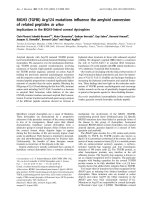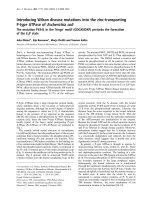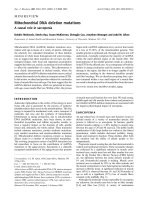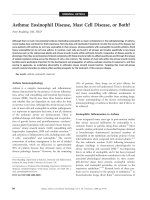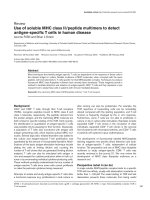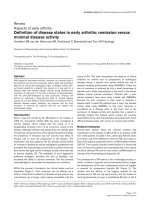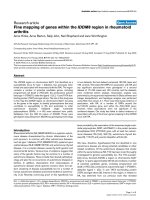Báo cáo Y học: Introducing Wilson disease mutations into the zinc-transporting P-type ATPase ofEscherichia coli The mutation P634L in theÔhingeÕ motif (GDGXNDXP) perturbs the formation of the E2P state pdf
Bạn đang xem bản rút gọn của tài liệu. Xem và tải ngay bản đầy đủ của tài liệu tại đây (266.14 KB, 8 trang )
Introducing Wilson disease mutations into the zinc-transporting
P-type ATPase of
Escherichia coli
The mutation P634L in the ÔhingeÕ motif (GDGXNDXP) perturbs the formation
of the E
2
P state
Juha Okkeri*, Eija Bencomo*, Marja Pietila¨ and Tuomas Haltia
Institute of Biomedical Sciences/Biochemistry, University of Helsinki, Finland
ZntA, a bacterial zinc-transporting P-type ATPase, is
homologous to two human ATPases mutated in Menkes
and Wilson diseases. To explore the roles of the bacterial
ATPase residues homologous to those involved in the
human diseases, we have introduced several point mutations
into ZntA. T he mutants P 401L, D628A and P 634L corres-
pond to the W ilson disease mutations P992L, D1267A and
P1273L, respectively. The mutations D628A and P634L are
located in t he C-terminal part of the phosphorylation
domain in the so-called hinge motif conserved in all P-type
ATPases. P401L resides near the N-terminal portion of the
phosphorylation domain w hereas the m utations H475Q and
P476L affect the heavy metal ATPase-specific HP motif in
the nucleotide binding domain. All mutants show reduced
ATPase activity corresponding 0–37% of the w ild-type
activity. The mutants P401L, H475Q and P476L are poorly
phosphorylated by both ATP and P
i
. Their dephosphory-
lation rates are slow. The D628A mutant is inactive and
cannot be phosphorylated at all. In contrast, the mutant
P634L six residues apart in the same domain shows normal
phosphorylation by ATP. However, phosphorylation by P
i
is almost absent. In the absence of added ADP the P 634L
mutant dephosphorylates much more slowly than the wild-
type, whereas in the presence of A DP the dephosphorylation
rate is faster tha n that of the w ild-type. We conclude th at the
mutation P634L affects the conversion between the states
E
1
PandE
2
P so t hat the mutant favors the E
1
or E
1
P state.
Keywords: P-type ATPase; Wilson disease mutation; heavy
metal transport; hinge motif; ion translocation.
P-Type ATPases form a large transporter protein family,
whose members share a few invariant or well-conserved
sequence patterns, although the overall degree of identity
among the sequences is rather low [1–3]. A charac teristic
feature i s t he presence of an aspartate i n the sequence
DKTG; this residue is phosphorylated by ATP during the
catalytic cycle, hence the term P-type ATPases. Sequence
motifs typical of the heavy metal transporting P-type
ATPases (P
1
-ATPases or CPx-ATPases) are presented in
Fig. 1.
The recently solved crystal structure of sarcoplasmic
Ca-ATPase [4] shows that the peripheral part of the enzyme
comprises three structural entities: the phosphorylation (P),
nucleotide binding (N) and actuator (A) domains. Four
transmembrane (TM) helices contribute to the binding site
of two calcium ions inside the lipid bilayer. The P domain, in
which the phosphorylated aspartate resides, is composed of
the N- and C-terminal parts of the longer cytoplasmic loop
(Fig. 1), whereas t he middle part of the loop makes up the N
domain. The A domain with its conserved TGES motif
contains residues from the shorter cytoplasmic loop. In the
crystal structure, both the N domain w ith the bound
nucleotide and the TGES motif of the A domain are some
25 A
˚
from the phosphorylated aspartate. Likewise, the
distance from the active aspartate to the bound substrate
ions in the TM domain is long (about 50 A
˚
). Thus the
structure does not directly reveal the molecular mechanism
of the ATP-powered ion translocation of the enzyme.
Because the bound ATP and the critical a spartate interact
during the phosphoryl transfer, the relative positions of N
and P are believed to change during catalysis. Moreover,
mutagenesis studies suggest that the A domain interacts
with the P domain [5]. In the crystal structure, the A domain
is a structurally independent and relatively far from the
other domains, which suggests that it should also move
significantly toward P during turnover.
In general, a P-type ATPase is t hought to operate by
interconverting between states termed E
1
and E
2
.These
state conversions are driven by consecutive phosphorylation
and dephosphorylation reactions. The binding of a sub-
strate ion to the site in the TM domain activates the ATPase
[6–9]. The terminal phosphate of ATP is then transferred to
the invariant aspar tate i n t he large p eripheral r egion.
Subsequently, the bound substrate ion is translocated
through the membrane simultaneously with the conversion
of the e nzyme from the E
1
P into t he E
2
P state. Finally, the
aspartyl phosphate is hydrolyzed and t he enzyme returns to
the initial state. It seems that the states E
1
and E
2
correspond to certain relative positions o f P, N and A
which a re structurally coupled to the ion binding site in the
TM domain. However, the exact mechanism of ion
translocation remains to be elucidated [10–12].
Correspondence to T. Haltia, Institute of Biomedical Sciences/Bio-
chemistry, PO Box 63 (Biomedicum Helsinki, Haartmaninkatu 8),
FIN-00014, University of Helsinki, Helsinki, Finland.
Fax: + 358 9 191 25444, Tel.: + 358 9 191 25407,
E-mail: fi
Abbreviations: TM, transmembrane; WD, Wilson disease.
*Note: These authors contributed equally to this study.
(Received 11 January 2002, accepted 23 January 2002)
Eur. J. Biochem. 269, 1579–1586 (2002) Ó FEBS 2002
The Escherichia coli genome codes for two heavy metal
transporting P-type ATPases, named ZntA and CopB,
which are involved in the transport o f zinc, lead, cadmium
and copper [13–16]. Both bacterial proteins are homologous
with the Wilson disease (WD) ATPase, possessing a number
of common sequence m otifs (see Fig. 1) [17–19]. The WD
ATPase is a copper pump. More than 100 m issense
mutations in 87 residues of t he WD ATPase are known to
associate with the disease [20]. About 30% of WD patients
carry the mutation H1069Q in the motif HP [16,17,21],
which appears to reside in the N domain of the protein [4].
WD is a rece ssively i nherited hepatic and neurologic
disorder, in which copper secretion to bile is defective
[17,21–23]. This leads to accumulation of toxic amounts of
copper in the liver, kidney and the brain. M utations of the
WD ATPase can result in a spectrum of d efects such as
impaired copper transport by correctly localized protein,
misfolding, degradation or mislocalization of the ATPase in
the endoplasmic r eticulum or the inability to undergo
copper-dependent trafficking [24,25]. The overall conse-
quence i s that there is no active WD ATPase molecules in
the trans-Golgi network, cytoplasmic vesicles or p lasma
membrane, which function in copper secretion in healthy
liver cells.
Here we have studied ZntA, a zinc-transporting ATPase
from E. coli, which belongs to the same subclass of P
1
-type
ATPases as the Wilson disease protein [26,27]. In this paper,
we report characterization of three site-directed mutants
P401L, D628A and P634L which mimic WD mutations
P992L, D1267A and P1273L, respectively. In addition, we
have studied the HP motif by characterizing the mutants
H475Q and P476L.
MATERIALS AND METHODS
Mutagenesis
TheZntAgeneofE. coli JM 109 had been cloned by PCR
and introduced into the pTrcHisA vector (Invitrogen) using
the restriction sites of BamHI and KpnI [26]. Site-directed
mutagenesis was carried out using the overlap extension
method [28,29]. The primers used can be found in Table 1 .
To rapidly identify the clones with desired mutations, a
Fig. 1. Membrane topology of ZntA. The positions of the phos-
phorylation, nucleotide binding and actuator d omains are shown. The
locations of several well-conserved sequence motifs as w ell as the
residues mu tated in this work are indicated. Circled P connected to
D436 denotes the invariant phosphorylated aspartate in th e P domain.
The motif CPX is an intramembraneous metal binding site present in
all heavy metal transporting P-type ATPases (X ¼ C,H,S). The
location of the domains and sequence motifs i s based on the crystal
structure of Ca-ATPase [4], the membrane topology of which is likely
to differ from that of ZntA.
Table 1. Primers used in mutagenesis of ZntA. Desired point mutations are marked in bold, the silent mutations are in italics. The extra restriction
site created by the sile nt mutation is underlined.
Mutation Primers
Restriction site(s)
Created Used in cloning
Pro401Leu
Fragment 1 Forward: 5¢-CAA CTG GCG TTT ATC GCG ACC ACG CT-3¢ NheI EcoNI/AgeI
Reverse: 5¢-GAG GTA ATC GCC
GCT AGC GTT GAG ATA AC-3¢
Fragment 2 Forward: 5¢-GTT ATC TCA AC
GCTA GCG GCG ATT ACC TC-3¢
Reverse: 5¢-CAG CGT ACC GGT TTT ATC AAA CGC CAC C-3¢
Pro476Leu
Fragment 1 Forward: 5¢-TAA AAC CGG TAC
GT T AAC CGT CGG TAA ACC G-3¢ HpaI AgeI/KpnI
Reverse: 5¢-CTT GCG CCA GTA GAT GCG TCG CG-3¢
Fragment 2 Forward: 5¢-CGC GAC GCA TCT ACT GGC GCA AG-3¢
Reverse: 5¢-CCC ATA TGG TAC CCC TTA TCT CCT GCG-3¢
Asp628Ala
Fragment 1 Forward: 5¢-TAA AAC CGG TAC
GT T AAC CGT CGG TAA ACC G-3¢ HpaI AgeI/KpnI
Reverse: 5¢-TCG TTA ATA CCG GCA CCG ACC ATC GCC A-3¢
Fragment 2 Forward: 5¢-TGG CGA TGG TCG GTG CCG GTA TTA ACG A-3¢
Reverse: 5¢-CCC ATA TGG TAC CCC TTA TCT CCT GCG-3¢
Pro634Leu
Fragment 1 Forward: 5¢-TAA AAC CGG TAC
GT T AAC CGT CGG TAA ACC G-3¢ HpaI AgeI/KpnI
Reverse: 5¢-GGC AGC TTT CAT CGC TAG CGC GTC-3¢
Fragment 2 Forward: 5¢-GAC GCG CTA GCG ATG AAA GCT GCC-3¢
Reverse: 5¢-CCC ATA TGG TAC CCC TTA TCT CCT GCG-3¢
1580 J. Okkeri et al. (Eur. J. Biochem. 269) Ó FEBS 2002
silent mutation producing an extra restriction site was also
introduced. All mutations were verified by sequencing the
relevant r egion of the expression construct. Partial charac-
terization of the mutant H475Q has been reported before
[26].
Expression of His-tagged ZntA
Wild-type and mutated versions of ZntA were expressed as
His-tagged recombinant proteins in E. coli TOP 10 as
described i n our previous work [26]. E xpression of the
protein was induced with 100 l
M
isopropyl thio-b-
D
-
galactoside 1 h 45 min after inoculation. Cells were harves-
ted 5 h after induction and stored at )20 °C.
Isolation of the membrane fraction and determination
of the expression levels
The membrane fraction of t he cells was isolated u sing the
protocol described before [26]. The membranes were
suspended into t he storage buffer ( 50 m
M
Tris, pH 8.0,
300 m
M
NaCl,20%glycerol,2m
M
2-mercaptoethanol,
0.5 m
M
phenylmethanesulfonyl fluoride) to a final concen-
trationof10mgofproteinÆmL
)1
andstoredat)70 °C.
Protein concentration was me asured with the BCA protein
assay kit (Pierce). The exp ression levels of the mutants we re
analyzed using SDS/PAGE on 12% gels combined with
Coomassie Blue staining (30 lg membrane protein per
lane), or with Western blotting w ith an a nti-HisG Ig
(Invitrogen). The intensitities of the Coomassie stained
bands assigned to monomeric recombinant ZntA were
quantified using
AIDA
software (version 2.00, Raytest
Isotopenmessgera
¨
te GmbH). The intensity values were used
to normalize the activity and phosphorylation measure-
ments so that the results in Figs 3–5 do not depend on the
expression levels of the mutants. In the Western b lotting
experiments, 10 lg of solubilized membrane protein was
analyzed on an SDS/PAGE gel a nd blotted on a poly
(vinylidene difluoride) membrane. His-tagged proteins were
visualized using a ProtoBlot II A P system for mouse
antibodies (Promega). For N-terminal sequence analysis,
proteins separated in SDS/PAGE were electrotransferred
onto a poly(vinylidene difluoride) membrane and stained
briefly with a Coomassie Blue solution prepared without
acetic acid. The 67-kDa band was identified and applied t o
an Applied Biosystems 477A protein s equenator.
ATPase activity measurements
The ATPase activity of the membrane fraction was
determined with the inorganic phosphate analysis method
[26,30], either in the absence of zinc, or in the presence of
20 l
M
ZnSO
4
.
Phosphorylation assays
Phosphorylation of the membrane fraction by [c-
33
P]ATP
and by
33
P
i
(Amersham Pharmacia) were carried out as
described previously [26], except that the total ATP
concentration was 2.5 l
M
and that 5 lCi of [c-
33
P]ATP
was used per reaction. The analysis of the phosphorylated
samples on acidic 8% SDS/PAGE and imaging of the g els
by a BAS-1800 Bio-imaging analyzer (Fuji) were performed
as described previously [26]. In this work only the monomer
(92 kDa) and the dimer (190 kDa) bands were analyzed.
The exposure times of the dried gels on the imaging plate
ranged from 1 to 5 h. The error bars in Figs 3–7 show the
standard deviation of three to four independent measure-
ments.
Dephosphorylation assays
The r ate of d ephosphorylation o f the p hosphoenzyme
intermediate was determined both in the absence of ADP
(dephosphorylation via the E
2
P intermediate) and i n the
presence of ADP (dephosphorylation directly from the E
1
P
form). The membrane fractions were first phosphorylated
with [c-
33
P]ATP as in the phosphorylation a ssay above in a
total volume of 680 lL (reaction to be stopped with EDTA)
or 540 lL (reaction to be stopped with EDTA and ADP).
Phosphorylation was allowed t o proceed for 30 s after
which the reaction was stopped with 5 m
M
EDTA with
250 l
M
ADP or with 5 m
M
EDTA alone. Samples of
160 lL were then taken at time points of 0 , 5, 10, 20 s and
1 min after a dding the stopper. When the EDTA/ADP
stopper was used, the last sample was taken at 20 s. The
samples were tran sferred to tubes containing 40 lLofcold
trichloroacetic acid. Due to technical reasons, the 0 s sample
had actually to be taken at 1 0 s prior t o adding the stopper.
However, a control experiment showed that the phosphory-
lation level of the ATPase was nearly constant for 2 min if
no EDTA was ad ded (results not shown). Samples were
analyzed as in the phosphorylation assays.
RESULTS
Expression of the mutants
Wild-type and mutant proteins were produced as
N-terminally His-tagged recombinant proteins. All mutant
polypeptides are expressed at levels clearly visible i n a
Coomassie stained SDS/PAGE gel (Fig. 2), which was
routinely used to estimate the amount of ZntA protein in
Fig. 2. Expression levels of the wild-type and mutant enzymes.
A standard SDS/PAGE gel stained with Coomassie b lue. The arrow
marked with M on the right points at the ZntA monomer (80 kDa).
The 67-kDa band, marked with F, is an N-terminally cleaved p ro-
teolytic fragment of the ATPase, persistently present despite the use of
protease inhibitors. The faint high molecular mass band may represent
a ZntA dimer (D). Samples were prepared from the membranes of the
vector only con trol strain (lane 1), wild-type (lane 2), P401L (lane 3),
H475Q (lane 4), P476L (lane 5), D628A (lane 6), P634L (lane 7). On
each lane of a 12% SDS/PAGE gel, 30 lgofmembraneproteinwas
loaded.
Ó FEBS 2002 Mutagenesis of ZntA (Eur. J. Biochem. 269) 1581
each membrane batch used for the assays described below.
The genomic ZntA gene is not expressed under our growth
conditions [26]. A major band at 80 kDa represents a ZntA
monomer,whereasaminorhighmolecularmassbandis
assigned to a ZntA dimer. T hese assignments were verified
using a W estern immunoblot with an antibody against the
His-tag (data not shown). A weaker band at 67 kDa i s not
recognized by the antibody, although it is clearly observed
in the phosphorylation assays (Figs 4 and 5). N-terminal
sequencing shows that it lacks the His-tag and the first 71
residues of ZntA. [The cleavage site is nine residues after the
CXXC motif (Fig. 1). The cleaved protein can be phos-
phorylated by ATP and P
i
. While its phosphorylation by
ATP seems very similar to that of t he uncleaved monomer
(Fig. 4A), the cleaved fragment is more intensely phosphor-
ylated by P
i
(Fig. 5A). Although the behavior of the
fragment may be o f interest, particularly regarding the
function of the CXXC domain, its properties are not those
of native ZntA. For th is reason, we have excluded t he
fragment from further analysis here.]
The H 475Q, D628A a nd P634L m utant proteins are
produced at levels similar to the wild-type. The amounts of
the P 401L and P476L ATPases are about 60% of the wild-
type level. In assays described below, the same amount of
total protein has been used. T he numerical values obtained
have then been normalized to the wild-type expression l evel
using normalizing factors determined from a Coomassie
stained SDS/PAGE gel (see Materials and methods).
ATPase activity
The zinc-stimulated ATPase activity of bacterial mem-
branes is specific for ZntA [26]. All mutants have a zinc-
dependent ATPase activity ranging from 0 to 37% of the
wild-type a ctivity (Fig. 3A), showing t hat the mutated
residues perform important roles in the ATPase. As
mentioned above, the mutant D628A is inactive, a finding
consistent with m utagenesis s tudies of sarcoplasmic
Ca-ATPase and chemical modification experiments wi th
Na,K-ATPase [31–33] (but, see [34]). In the crystal structure
of sarcoplasmic Ca-ATPase (in the E
1
state) [4], the
counterpart of D628 is D703 which resides in the proximity
of the phosphorylated aspartate D351. It may be hydrogen-
bonded to another invariant aspartate (D707) in the hinge
motif.
The mutant P401L has about 18% of the ATPase activity
left (Fig. 3). Because this mutation is located nine residues
toward the C-terminus from the metal binding site (the
motif CPC in the sixth TM helix of ZntA in Fig. 1), the low
zinc dependent ATPase activity could be a consequence of
decreased affinity of the metal binding site. To study this
possibility, we measured the ATPase activity of the wild-
type and P401L ATPases in different concentrations of zinc.
The mutational effect cannot be compensated for by
increasing the c oncentration of t he metal i on (data not
shown), suggesting t hat the low A TPase activity of t he
P401L mutant is not due to lowered affinity for zinc.
Phosphorylation by ATP and P
i
The phosphorylated intermediate which is formed during
the transport cycle is a hallmark of all P-type ATPases. In
ZntA, phosphorylation b y ATP is stimulated by Zn
2+
,
Cd
2+
,Pb
2+
and Cu
2+
[26]. T he resulting E
1
Pstatecan
react with ADP to remake ATP. In contrast, in the absence
of substrate ions, ZntA and other P-type ATPases can be
pulled into the E
2
state and be phosphorylated by inorganic
phosphate P
i
[9]. The E
2
P state is ADP insensitive.
The inactive mutant D628A is not phosphorylated at all
by ATP (Fig. 4), consistent with the properties of the
corresponding mutan t of the sarcoplasmic C a-ATPase [31].
The m utant P401L retains 12% of the w ild-type phos-
phorylation by ATP, thus exhibiting a m arked reduction in
the formation of the ADP-sensitive phosphointermediate.
The mutants of the HP motif (H475Q and P476L) show
ATP-driven phosphorylation l evels of 32% and 26% of the
wild-type, respectively. In contrast, the P634L mutant has
less than 10% of the A TPase activity left but nevertheless
shows normal phosphorylation by ATP (Fig. 4). We
conclude that the mutation interferes with a catalytic step
which is beyond the ATP-dependent phosphorylation
reaction.
The wild-type ZntA reacts with P
i
in the absence of zinc
(Fig. 5 ); if 30 l
M
Zn
2+
is present, phosphorylation by P
i
decreases to 20% of the maximal level (Fig. 5C). All the
mutants are much less reactive with P
i
than the wild-type
(Fig. 5A,B). In particular, while the P634L mutant phos-
phorylates almost normally with ATP, hardly any phos-
phorylation is observed with P
i
. With the mutant P401L, the
remaining P
i
-phosphorylation (8% of the wild-type level) is
less sensitive to t he presence of Zn
2+
than in the wild-type
(Fig. 5 C).
Dephosphorylation kinetics
In addition to measuring the formation of aspartyl phos-
phate, the catal ytic cycle of a P-type ATPase c an be
characterized by determining the decay rate of t he phos-
phorylated intermediate. The aspartyl-phosphate com-
pound can decompose in two ways: in the normal,
forward reaction along the route E
1
P fi E
2
P fi E
2
,
or, in the presence of extra ADP, in a reversal of the normal
reaction E
1
P fi E
1
(plus ATP).
The P401L mutant dephosphorylates more slowly than
the wild-type both in the absence a nd in the p resence of
Fig. 3. Normalized zinc-dependent ATPase activity of the wild-type and
mutated enzymes. TheATPaseactivity(percentageoftheactivityofthe
wild-type) present in membranes shown. The ATPase activity present
in the a bsence of zinc has bee n subtracted. The concentration o f zinc
was 20 l
M
.Ineachmeasurement,50lgofmembraneproteinwas
used. The error bar is the standard deviation of three to four meas-
urements.
1582 J. Okkeri et al. (Eur. J. Biochem. 269) Ó FEBS 2002
ADP (Fig. 6). In contrast, the behavior of the P634L
enzyme is strikingly different depending on whether ADP is
present or not. In the forward reaction, i.e. in the absence of
added A DP, the P634L ATPase has a clearly slower
dephosphorylation r ate than the wild-type (Fig. 6A). How-
ever, in the presence of 250 l
M
ADP (a hundred-fold excess
of ADP compared to ATP), the enzyme behaves like the
wild-type and is fully dephosphorylated after 5 s (Fig. 6B),
which, for technical reasons, is the first time point. To slow
down the dephosphorylation reaction, the concentration of
ADP was reduced to 25 l
M
. Under these conditions, the
P634L ATPase dephosphorylates faster than the wild-type
enzyme (Fig. 6 C).
The dephosphorylation rates of the P476L ATPase are
slow in both assays (Fig. 7). Even in the presence of excess
ADP, the dephosphorylation is considerably slower t han
that of the wild-type enzyme. The mutant H475Q, targeted
at the neighboring r esidue in th e HP m otif, behaves
essentially the same way but the effects are slightly milder
compared to the mutant P476L (Table 2).
DISCUSSION
We have used here a b acterial zinc transporting P-type
ATPase to study the effects of five site-specific mutations, of
which four mimic m utations found in WD patients. All our
ZntA mutants have clear functional defects. However, one
of the most common WD mutations (H1069Q, correspond-
ingtoH475QinZntA)hasbeenshowntoresultin
mislocalization of t he WD ATPase in the endoplasmic
reticulum [24]. This trafficking defect as well the difficulty of
producing enough of mutant protein has complicated the
attempts to study the roles of the ATPase residues mutated
in WD. By using a bacterial system, we have been able to
overcome these problems (for an analogous study, see Bissig
et al.[27]).
Owing to the recent elucidation of the crystal stucture of
Ca-ATPase [4], we c an interpret some of the results in a
structural context. As deduced from the Ca-ATPase struc-
ture, two of our ZntA mutants (D628A and P634L) reside
in the P domain while two (H475Q and P476L) are likely to
be in the N domain. The well-conserved residue P401 is
Fig. 4. Phosphorylation of the wild-type and mutant enzymes with
33
P-ATP in the presence of zinc. (A) Phosphoproteins visualized in
acidic SDS/PAGE. The major bands are thought to represent a ZntA
multimer, dimer (apparent molecular mass about 200 kDa), monomer
(97 kDa) and a proteolytic fragment (66 kDa), respectively. Mem-
branes from the vector-only control s train d o n ot sh ow any bands [26].
Membranes from the wild-type (lane 1), P401L (lane 2), H475Q
(lane 3), P476L (lane 4), D628A (lane 5), P634L (lane 6). The phos-
phorylation reaction was performed on ice at pH 6.0 using 2.5 l
M
ATP and a labeling t ime of 30 s (see Materials an d methods). The
concentrat ion of Zn
2+
was 30 l
M
25 lg of membrane protein of was
loaded on each lane of an acidic 8% SDS/PAGE gel. (B) Quantitation
of the intensity of monomer and dimer bands. The background
phosphorylation measured with no zinc present has been subt racted.
The data has been n ormalized to the same concentration of ZntA.
Fig. 5. Phosphorylation of the wild-type and mutant enzymes with
33
P
i
.
(A) P hosphorylatio n of the wild-type and mutant proteins in the
absence of zinc. wild-type (lane 1), P401L (lane 2), H475Q (lane 3),
P476L (lane 4), D628A (lane 5), P634L (lane 6). The phosphorylation
reaction was performed at room temperature at pH 6.0 using 100 n
M
33
P
i
and a labeling time of 10 min. On each lane of the acidic
SDS/PAGE gel, 25 lg of membrane protein was loaded. Membranes
from the vector-only control strain do not contain any phosphorylated
ZntA [26]. ( B) Quantitation of the inten sity of monomer and d imer
bands. The data has been normalized as above. (C) The effect of 30 l
M
Zn
2+
on the P
i
-phosphorylation of the wild-type and the P401L
enzymes (gray columns). Note that the maximal phosphorylation of
the P401L mutant is only 8% of the wild-type level (see Fig. 5B). White
columns, no added zinc present.
Ó FEBS 2002 Mutagenesis of ZntA (Eur. J. Biochem. 269) 1583
located in a sequence that connects t he putative m etal
binding site in the TM domain to the phosphorylation site
D436. D628A and P634L are both situated in the highly
conserved hinge motif near the C-terminal end of the P
domain. Residues H475 and P476 form the so-called HP
motif, which is characteristic for heavy metal transporting
P-type ATPases. A summary of the mutational e ffects is
presented i n Table 2.
The P401L mutant has some 12% of the zinc-dependent
ATPase activity left, is poorly phosphorylated by both ATP
and P
i
and its both dephosphorylation rates are slow. The
remaining phosphorylation by P
i
is not as sensitive to zinc as
it is in the wild-type. The mutation thus influences many
steps in the phosphorylation cycle. One way t o explain such
a general effect is to assume that the function of the
phosphorylation site itself is affected. As indicated in Fig. 1,
P401 resides near the cytoplasmic end of the sixth TM helix.
Inspection of the Ca-ATPase structure shows th at this helix
(the fourth TM helix in Ca-ATPase) is partially unwound in
its middle portion. Assuming a similar s tructure for ZntA,
P401 should be located in the cytoplasmic helical portion
close to t he membrane-aqueous interphase. This helix
connects the metal binding site to the P domain and its
catalytic aspartate (D 436 in ZntA). For this rea son, a
plausible i nterpretation o f the data is that the mutant has a
defect in the communication between the metal binding and
phosphorylation sites. It should be noted that binding of the
metal ion initiates the catalytic cycle [6]. This binding event
in the TM part should trigger changes in the P and N
domains; these changes are prerequisites for further c atalytic
Fig. 7. Dephosphorylation kinetics of t he
wild-type (m) and the mutants H475Q (j)
and P476L (r). Analysis of the dephos-
phorylation rate in t he absence of A DP (A)
and in the prese nce of 250 l
M
ADP (B).
Experimental conditions as in F ig. 6.
Fig. 6. Dephosphorylation kinetics of the w ild-type (m) and the mutants P401L (h) and P63 4L (e). Phosp horylation conditions as in Fig. 4. After 3 0
s labeling reaction with A TP, the reaction w as s topped with 5 m
M
EDTA (A), 250 l
M
ADP a nd 5 m
M
EDTA (B) or 25 l
M
ADP and 5 m
M
EDTA
(C). For each time point, 25 lg of m embrane protein was analysed on a lane of an acidic SDS/PAGE gel.
Table 2. Summary of the mutational effects relative to the wild-type. The activity values have be en normalized as explained in the text.
Mutant
ATPase
activity
(%)
Phosphorylation (%) Dephosphorylation
Interpretation
by ATP by P
i
by ADP
P401L 18 12 8 Slow Slow Communication between the metal binding site
and the P domain is affected.
H475Q 37 32 14 Slow Slow Interaction between the N and P domains is affected.
An effect on nucleotide binding is also possible.
P476L 23 26 11 Slow Slow As above.
D628A 0 0 3
a
– – The mutant is unable to phosphorylate itself.
D628 plays a role in the catalytic site.
P634L 7 100 2
b
Slow Very fast The mutant is impaired in the transitions E
1
-P fi E
2
-P
and E
2
fi E
2
P.
It favours the E
1
state. P634 may reside at the interface
between the domains P and A.
a
No clear bands. Only smear observed.
b
Weak but clear dimer and monomer bands observed.
1584 J. Okkeri et al. (Eur. J. Biochem. 269) Ó FEBS 2002
steps. Defective allosteric communication between the metal
site and the P domain m ay thus result in a general defect in
the phosphorylation cycle as observed here. We suggest that
P401 plays a role in c oupling the me tal binding and
phosphorylation sites.
The counterparts of D628 and P634 in Ca-ATPase, D703
and P709, respectively, are located near the phosphorylated
D351 and constitute part of the phosphorylation site [4].
The crystal structure by Toyoshima et al.[4]showsthat
D703 may be hydrogen-bonded to the invariant D707 of the
hinge m otif. I n ZntA, the mutation D628A inactivates t he
ATPase. Moreover, this mutant could not be phosphoryl-
ated at all in our assays, which is expected if the mutated
residue has an essential structural and/or catalytic function
in the phosphorylation site. Similar results have been
reported f rom studies of the corresponding site-directed
mutant of the sarcoplasmic Ca-ATPase [31]. However,
Pedersen et al. [34] found that the analogous mutation in
the Na
+
/K
+
-ATPase yielded an enzyme with 20% of the
wild-type ATPase activit y. Regarding the r ole of D628,
several recent studies agree that this residue is involved in
binding of Mg
2+
[34–37]. Moreover, the E
1
to E
2
transition
may be linked to changes in Mg
2+
ligation so that in the E
1
state Mg
2+
is ligated by residues in the hinge motif in the P
domain and by residues in the N domain, whereas in the E
2
state the latter are replaced by residues in the TGES motif of
the A domain [ 37] (cf. [34,35]). Taken t ogether, both
mutagenesis and structural data agree that D628 has a very
important role in the phosphorylation site of P-type
ATPases. A direct catalytic function, such as assisting i n a
step during the phosphoryl transfer, is possible.
The P634L mutant retains less than 10% of the wild-type
ATPase activity, but phosphorylation with ATP is normal.
Yet, phosphorylation with P
i
is almost completely lost. The
phosphorylation r esults suggest that the mutation stabilizes
the E
1
conformation, leading to the accumulation of the
species E
1
P in the phosphorylation experiment with ATP.
This conclusion is supported by t he dephosphorylation
studies in which t he mutant showed a very fast A DP-
dependent dephosphorylation, whereas the normal, forward
dephosphorylation via the E
2
state was slow. The role of
P634 has also been studied in the case of Ca-ATPase by
substituting it with an alanine ( mutant P709A [31]). This
mutant, ho wever, showed a much milder phenotype (60%
of the wild-type ATPase activity and almost wild-type
phosphorylation properties) than our mutant which
mimicks a pathogenic WD mutation. In the structure of
the Ca-ATPase in the E
1
state [4], P709 is solvent-exposed; it
is possible that the tolerance for the s ubstitutions at this site
is related to the size and hydrophobicity of the substituting
side chain. Inspection of a theoretical model of the
Ca-ATPase in the E
2
state ( PDB accession no. 1FQU;
F. Nakasako & C. Toyoshima Tokyo University, Japan)
suggests that P709 can interact with the A domain (see also
[37]). In any event, our results s upport the idea that the
hinge m otif GDGXNDXP is not only directly involved in
the phosphorylation reaction, but may also be important for
the E
1
to E
2
conversion.
The mutants H475Q (which is analogous to one of the
most common W ilson disease mutations, H1069Q of WD
ATPase) and P476L have similar c haracteristics. They
retain 37% and 23% of the wild-type A TPase activity,
respectively, and are poorly phosphorylated by ATP and P
i
.
Low but significant ATPase activity and phosphorylation
by ATP were a lso observed in the CopB mutant equivalent
to H475Q [27]. Both our mutants are dephosphorylated
slowly in the forward reaction (no ADP added) as well as in
the ADP-dependent dephosphorylation. The latter obser-
vation, taken together w ith the likely location o f the HP
motif in the N domain, might indicate that these mutants
have a defect in nucleotide binding. In o rder the phos-
phorylation reaction to occur, the N domain with bound
ATP must interact with the P domain. The mutations in the
HP motif might perturb this interaction resulting in a state
intermediate between E
1
and E
2
. This would provide an
explanation f or the i mpaired P
i
phosphorylation, which
requires t he occupation of the E
2
state. The s everely
impaired ADP-dependent dep hosphorylation indicates that
also the E
1
state of the mutant differs from that of the
wild-type. Interestingly, the nearby WD mutation homo-
logue E470A results in an ATPase that prefers the E
2
state
[26].
In conclusion, we have demonstrated that ZntA can be
used to study the functional consequences of mutations that
are analogous to those causing WD. From the enzymolog-
ical point of view, c haracterization of t he mutants t hat
imitate the pathogenic mutants can yield interesting func-
tional data about P-type ATPases. In particular, we have
shown here that P634 in the hinge motif plays a role in the
transition between the states E
1
and E
2
. Together with the
recent determination of the crystal structure of the sarco-
plasmic Ca-ATPase [4], analysis of these and other WD
mutant homologues may help in further d elineating the key
features of these complex ion pumps.
ACKNOWLEDGEMENTS
We thank Dr Pentti Somerharju for comments on the manuscript,
Dr Marc Baumann for N-terminal sequencing and K atja Sissi, Teija
Inkinen and Lea A rmassalo for help with laboratory work. Financial
support was provided by the University of Helsinki, the Academy of
Finland (program 44895), the M agnus Ehrnrooth F oundation, and the
Sigrid Juselius Foundation.
REFERENCES
1. Skou, J.C. & Esmann, M. (1992) The Na,K-ATPase. J. Bioenerg.
Biomembr. 24, 249–261.
2. Pedersen, L.P. & Carafoli, E. (1987) Ion motive ATPases. I.
Ubiquity, p roperties, and significance to cell function. Trends
Biochem. Sci. 12, 146–150.
3. Camakaris, J., Voskoboinik, I. & Mercer, J.F. (1999) Molecular
mechanisms of copper homeostasis. Biochem. Biophys. Res.
Commun. 261, 225–232.
4. Toyoshima, C., Nakasako, M., Nomura, H. & Ogawa, H. (2000)
Crystal s tructure of the calcium pump of sarco plasmic reticulum
at 2.6 A
˚
resolution. Nature 405, 647–655.
5. Clarke, D.M., Loo, T.W. & MacLennan, D.H. (1990) Functional
consequences of mutations of c onserved amino acids in the be ta-
strand domain of the Ca
2+
-ATPase of sarcoplasmic reticulum.
J. Biol. Chem. 265, 14088–14092.
6. Voskoboinik, I., M ar., J., Strausak, D. & Camakaris, J. (2001)
The regulation of catalytic activity of the Menkes copper-trans-
locating P-type ATPase. Role of high a ffinity c opper-binding s ites.
J. Biol. Chem. 276, 28620–28627.
7. De Meis, L. & Vianna, A.L. (1979) Energy interconvers ion by the
Ca
2+
-dependent ATPase of the sarcoplasmic reticulum. Annu.
Rev. Biochem. 48, 275–292.
Ó FEBS 2002 Mutagenesis of ZntA (Eur. J. Biochem. 269) 1585
8. Inesi, G. (1985) Mechanism of calcium transport. Annu. Rev.
Physiol. 47, 573–601.
9. Vilsen, B. (1995) Structure–function relationships in the Ca
2+
-
ATPase of sarcoplasmic reticulum studied by use of the substrate
analogue CrATP and site-directed mutagenesis. Comparison with
the N a
+
,K
+
-ATPase. ActaPhysiol. Scand. 154 (Suppl. 624),1–146.
10. Danko, S., Daiho, T., Yamasaki, K., Kamidochi, M., Suzuki, H.
& Toyoshima, C. (2001) ADP-insensitive phosphoenzyme inter-
mediate of s arcoplasmic r eticulum Ca
2+
-ATPase has a compact
conformation resistant to proteinase K, V8 protease and tryp sin.
FEBS Lett. 489, 277–282.
11. Stokes, D.L., Zhang, P., Toyoshima, C., Yon ekura, K., Ogawa, H .,
Lewis, M.R. & Shi, D. (1998) Cryoelectron microscopy of the
calcium pump from sarcoplasmic reticulum: two crystal forms
reveal two different conformations. Acta Phys. Scand. 163 (Suppl.
643), 35–43.
12. Ku
¨
hlbrandt, W., Auer, M. & Scarborough, G.A. (1998) Structure
of the P-type AT Pases. Curr. Opin. Struct. Biol. 8, 510–516.
13. Beard, S.J., Hashim, R., Membrillo-Hernandez, J., Hughes, M.N.
& Poole, R.K. (1997) Zinc (II) tolerance in Escherichia coli K-12:
evidence that the zntA gene (o732) encodes a cation transport
ATPase. Mol. Microbiol. 25, 883–891.
14. Rensing, C., Mitra, B. & Rosen, B.P. (1997) The zntA gene of
Escherichia coli encodes a Zn (II) -t ranslocating P-type AT Pase.
Proc. Natl Acad. Sci. USA 94, 14326–14331.
15. Rensing, C., Sun, Y., M itra, B. & Rosen, B.P. (1998) Pb (II) -
translocating P-type ATPases. J. Biol. Chem. 273, 32614–32617.
16. Rensing, C., Fan, B., Sharma, R., Mitra, B. & Rosen, B.P. (2000)
CopA: An Esche richia coli Cu(I)-translocating P-type ATPase.
Proc. Natl Acad. Sci. USA 97, 652–656.
17. Solioz, M. & Vulpe, C. (1996) CPx-type ATPases: a class of P-type
ATPases that pump heavy metals. Trends Biochem. Sci. 21,
237–241.
18. Lutsenko, S. & Kaplan, J.H. ( 1995) Organization of P -type
ATPases: significance of structural diversity. Biochem ist ry 34,
15607–15613.
19. Møller, J.V., J uul, B. & le Maire, M. (1996) Structural organiza-
tion, ion transport, and energy transduction of P-type ATPases.
Biochim. Biophys. Acta 1286, 1–51.
20. Cox, D.W. Wilson disease mutation database available from
/>21. Cox, D.W. (1999) Disorders of copper transport. Br.Med.Bull.
55, 544–555.
22. Roberts, E.A. & Cox, D.W. (1998) Wilson disease. Bail liere’s Clin.
Gastroenterol. 12, 237–256.
23. Sarkar, B . (1999) T reatment of Wilson and Menkes diseases.
Chem. Rev. 99, 2 535–2544.
24. Payne, A.S., K elly, E.J. & Gitlin, J.D. (1998) Functional expres-
sion of the W ilson disease protein reveals mislocalization and
impaired coppe r-depende nt traffi ck ing o f t he co mmon H1069Q
mutation. Proc. Natl Acad. Sci. USA 95, 10854–10859.
25. Forbes, J.R. & Cox, D.W. (2000) Copper-dependent trafficking of
Wilson disease mutant ATP7B proteins. Hum. Mol. Genet. 9,
1927–1935.
26. Okkeri, J. & Haltia, T. (1999) Expression and mutagenesis of
ZntA, a zinc-transporting P-type ATPase from Escherichia coli
Biochemistry 38, 14109–14116.
27. Bissig, K.D., Wunderli-Ye, H., Duda, P.W. & Solioz, M. (2001)
Structure-function analysis of purified Enterococcus hirae CopB
copper ATPase: e ffect of Menkes/Wilson disease mu tation
homologues. Biochem. J. 357, 217–223.
28. Higuchi, R., Krummel, B. & Saiki, R.K. (1988) A general method
of in vitro preparation and specific mutagenesis of DNA frag-
ments: study of protein and DNA interactions. Nucleic Acids Res.
16, 7351–7367.
29. Ho, S.N., Hunt, H.D., Horton, R.M., Pullen, J.K. & Pease, L.R.
(1989) Site-directed mutagenesis by overlap extension using the
polymerase chain reaction. Gene 77 , 51–59.
30. Lutter, R., Saraste, M., van Walraven, H.S., Runswick, M.,
Finel, M., Deatherage, J.F. & Walker, J.E. (1993) F
1
F
0
-ATP
synthase from bovine heart mitoc hondria: developm ent of the
purification of a monodisperse oligomycin-sensitive AT Pase.
Biochem. J. 295, 799–806.
31. Vilsen, B., Andersen, J.P. & MacLennan, D.H. (1991) Functional
consequences of alteration s to amino acids l ocated in the hinge
domain of the Ca
2+
-ATPase of sarcoplasmic reticulum. J. B iol.
Chem. 266, 16157–16164.
32. Lane, L.K., Feldmann, J.M., Flarsheim, C.E. & Rybczynski, C.L.
(1993) Expression of rat alpha 1 Na,K-ATPase containing sub-
stitutions of ÔessentialÕ amino acids in the catalytic center. J. Biol.
Chem. 268, 17930–17934.
33. Ovchinnikov, Y.A., Dzhandzugazyan, K.N., Lutsenko, S.V.,
Mustayev, A.A. & Modyanov, N.N. (1987) Affinity modification
of E
1
-form of Na
+
,K
+
-ATPase revealed Asp-710 in the catalytic
site. FEBS Lett. 217, 111–116.
34. Pedersen, P.A., Jørgensen, J.R. & Jørgensen, P.L. (2000)
Importan ce o f conserved alpha -subunit segm ent 709GDGVND
for Mg
2+
binding, phosphorylation, and ene rgy transdu ction in
Na,K-ATPase. J. Biol. Chem. 275, 37588–37595.
35. Farley, R.A., Elquza, E., M u
¨
ller-Ehmsen, J., Kane, D.J., Nagy,
A.K., Kasho, V.N. & Faller, L.D. (2001)
18
O-Exchange evidence
that mutations of arginine in a signatu re sequence for P-type
pumps affe ct i norganic p hosp hate b inding. Biochemistry 40, 6361–
6370.
36. Ridder, I.S. & Dijkstra, B.W. (1999) Identification of the Mg
2+
-
binding site in the P-type ATPase and phosphatase m embers
of the HAD (haloacid halogenase) superfamily by structural
similarity to the r esponse r egulator CheY. Bioc hem. J. 339,
223–226.
37. Shin, J.M., Goldshleger, R., Munson, K.B., Sachs, G. & Karlish,
S.J.D. (2001) Selective Fe
2+
-catalyzed oxidative cleavage of
gastric H
+
,K
+
-ATPase. J. Biol. Chem. 276, 4 8440–48450.
1586 J. Okkeri et al. (Eur. J. Biochem. 269) Ó FEBS 2002

